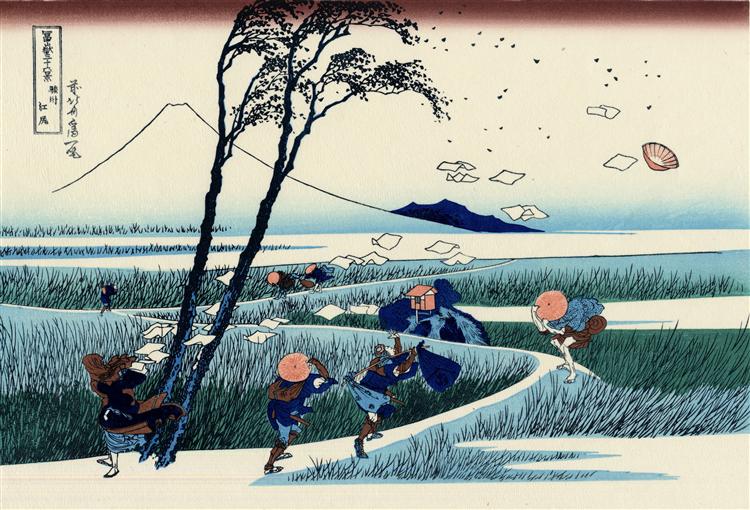Description
Katsushika Hokusai's Ejiri in Suruga Province (1832) falls within the elegant and meticulous world of ukiyo-e, a style of Japanese printmaking and painting that flourished between the 17th and 19th centuries. One of the most prominent figures in this artistic movement, Hokusai presents an evocative scene in this work that captures both the essence of the Japanese landscape and the everyday experience of its people.
The first thing that catches your attention when looking at this painting is its composition. In the foreground, a series of wooden boats can be seen flowing smoothly on the river that runs through the scene. The arrangement of these boats adds a visual dynamic that guides the viewer's gaze towards the mountains that rise majestically in the background. The use of vertical and horizontal lines provides a sense of stability and structure, while the layering of the elements in the work creates depth and perspective. This skill in handling composition is a distinctive feature of Hokusai's artistic practice.
The color palette used in “Ejiri in Suruga Province” is rich and diverse, with shades of blue that evoke river water and skies predominating. These blues blend harmoniously with green and earthy tones that represent the surrounding vegetation, creating a sense of natural unity. Through the technique of ukiyo-e, Hokusai manages to convey a sense of acclaim for the ephemeral beauty of nature, something that is recurrent in his work. The application of colors, with their subtle transitions and gradations, reinforces the calm and contemplative atmosphere of the scene depicted.
Although the focus of the work is on the landscape, the presence of human figures is also hinted at, which are subtly represented on the boats. These figures, although not the main focus, offer us a glimpse of the daily life of the time, reflecting the relationship between humans and their natural environment. The inclusion of these human figures suggests a dialogue between the landscape and its inhabitants, a recurring theme in Hokusai's work.
It is interesting to note that “Ejiri in Suruga Province” is part of the series “Thirty-six Views of Mount Fuji”, one of Hokusai’s most famous works, where Mount Fuji appears in different contexts and situations. Through this series, Hokusai not only paid tribute to Japan’s sacred mountain, but also explored the interaction of landscape with daily life, capturing the fragility and power of nature.
Ultimately, Hokusai's impact goes far beyond his time. His ability to depict an intimate connection between humans and the natural environment has influenced a range of artistic movements worldwide, from Impressionism to contemporary art. "Ejiri in Suruga Province" is not only a testament to the artist's technical mastery, but also a visual meditation on the beauty of nature, movement, and man's relationship to his world.
In conclusion, Hokusai's work remains a benchmark of Japanese aesthetics and a bridge to understanding sensitivity towards nature in art. "Ejiri in Suruga Province" stands not only as a magnificent example of his technique, but also as an invitation to reflect on our own connection with the world around us.
KUADROS ©, a famous painting on your wall.
Hand-made oil painting reproductions, with the quality of professional artists and the distinctive seal of KUADROS ©.
Painting reproduction service with satisfaction guarantee. If you are not completely satisfied with the replica of your painting, we will refund 100% of your money.

